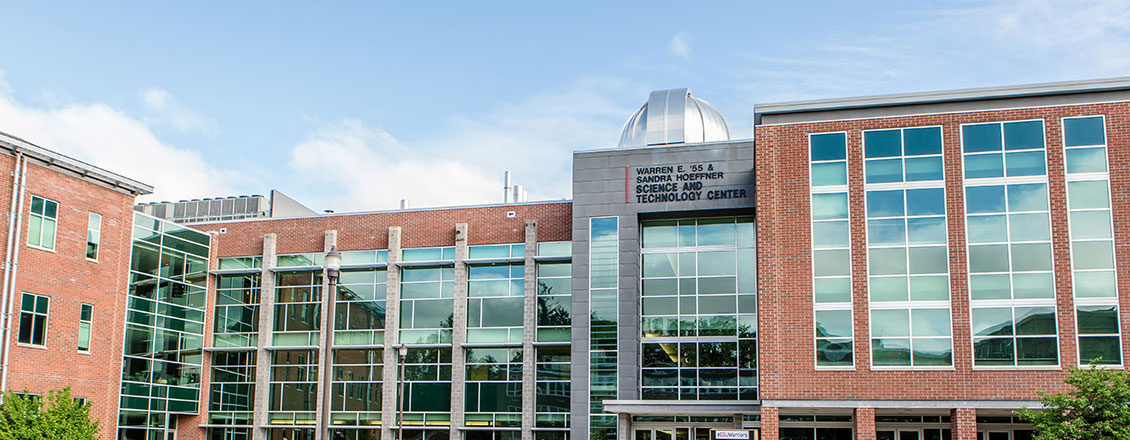
Instrumentation
Chemistry and Biochemistry Instrumentation
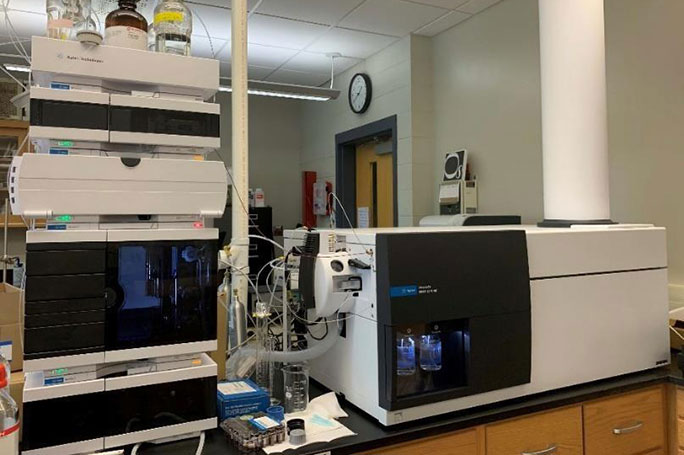
Agilent LC/Q-TOF Mass spec
Liquid chromatography (LC) separates the sample components and then introduces them to the mass spectrometer (MS). The MS creates and detects charged ions. Once detected, spectra of relative abundance against the ratio of mass/charge (m/z) are generated. These spectra are used to determine molecular masses of molecules under investigation, provide more data for structural elucidation, detect reaction (by) products.
Agilent 6545XT AdvanceBio MS QTOF is coupled with the 1260 Infinity II LC system This LC offers a broad range of analytical applications with high reliability, performance, and precision. The QTOF is designed to optimize the characterization of biomolecules. It possesses the SWARM autotune function for optimal performance and detection at the sub-nanogram level with mass accuracies within 10 ppm. Its application in proteomics includes peptide mapping, detection of PTMs, intact protein analysis, etc. It is also suitable for metabolomics, forensic analyses, environmental analyses, and clinical applications.
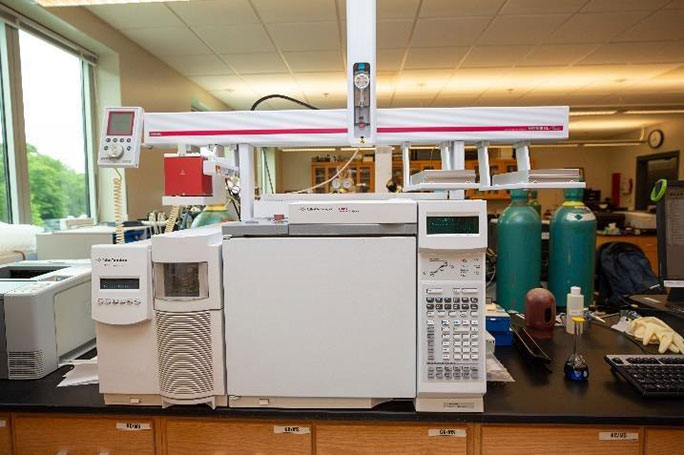
Agilent Gas Chromatography Mass Spectrometry (GC/MS)
The Agilent GC-MS targets small and volatile molecules. It has high performance for a broad range of samples and applications. It is the analysis method of choice for smaller and volatile molecules such as alcohols, aromatics, and simple molecules such as steroids, fatty acids, and hormones. It can be used for the analyses of lipids, hormones, and fatty acid content in foods (Agro industry), environmental contaminants, and blood toxins (toxicology/forensics).
This instrument has a high retention time and area reproducibility due to its unique temperature and pneumatic control. Its digital range supports the quantification of small and larger sample peaks in one run. This instrument has standard Atmospheric pressure and temperature balance; hence fluctuations in the lab environment do not impact results. This instrument has a high retention time and area reproducibility due to its unique temperature and pneumatic control. Its digital range supports the quantification of small and larger sample peaks in one run. This instrument has standard atmospheric pressure and temperature balance; hence fluctuations in the lab environment do not impact results.
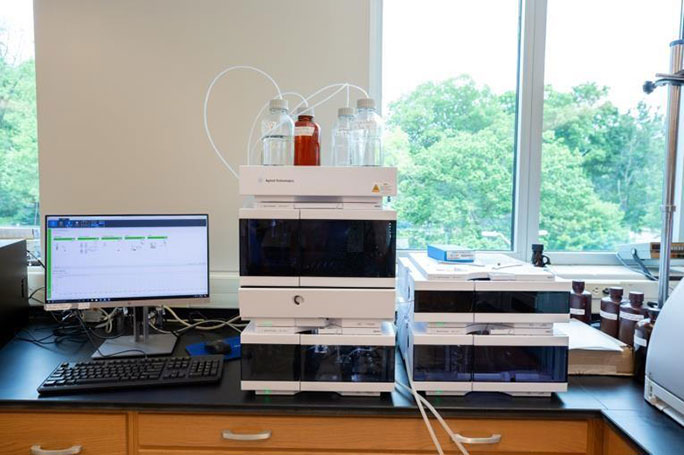
Agilent High performance liquid chromatography (HPLC)
It is a technique in analytical chemistry used to separate, identify, and quantify each component in a liquid mixture.
The Agilent 1260 Infinity Quaternary HPLC offers the most flexibility for solvent selection and automation in HPLC method development, research and all HPLC applications requiring continuous access to a wide range of solvent choices.
It is ideally suitable for multimethod, high-throughput workflows.
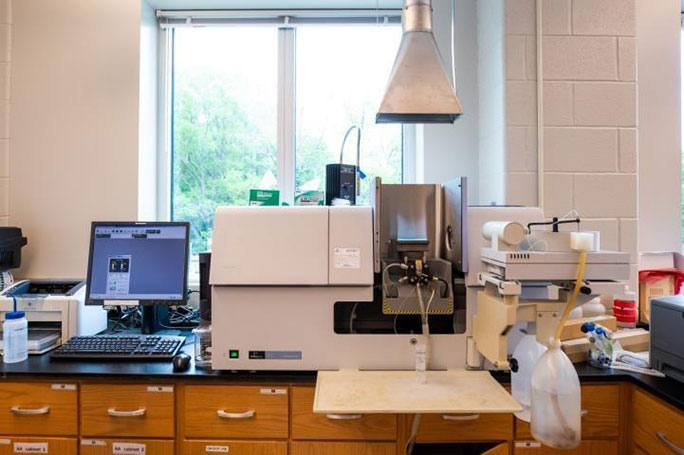
Perkin Elmer Atomic Absorption Spectroscopy
The Aanalyst 800 spectrometer is a robust spectrometer with state-of-the-art performance.
It quantifies elements in solution by passing them through an acetylene flame, and concentrations determined by comparisons to known standards.
This instrument contains a unique temperature control system, ensuring an interference-free metal analysis.
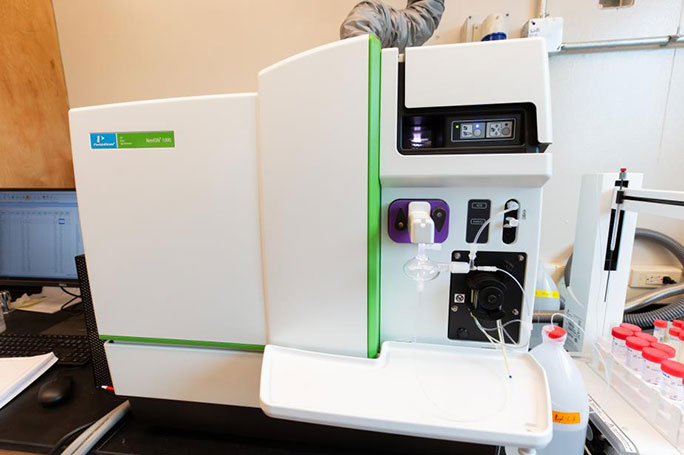
PerkinElmer NexION® 1000 ICP-MS
It is an excellent tool for elemental analyses. It houses the automated, robust and highly efficient S23 autosampler.
Its extended dynamic range offers it a unique LOD and ULD. The ICP-MS analyses are simplified using an argon stream, resulting in high quality data.
Detection and quantification of heavy metals in water, detection of contaminants in eye drops, metal analysis in cannabis, are a few applications of this instrument.
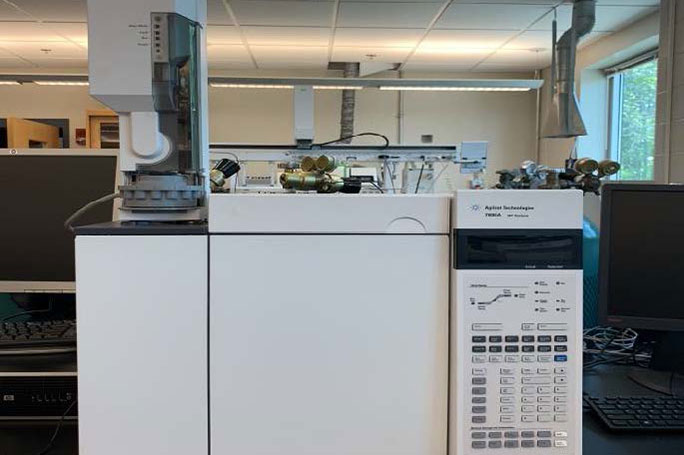
Agilent Gas Chromatograph GC 7890
Gas chromatography is a common type of chromatography used in analytical chemistry for separating and analyzing compounds that can be vaporized without decomposition.
Typical uses of GC include testing the purity of a particular substance, or separating the different components of a mixture.
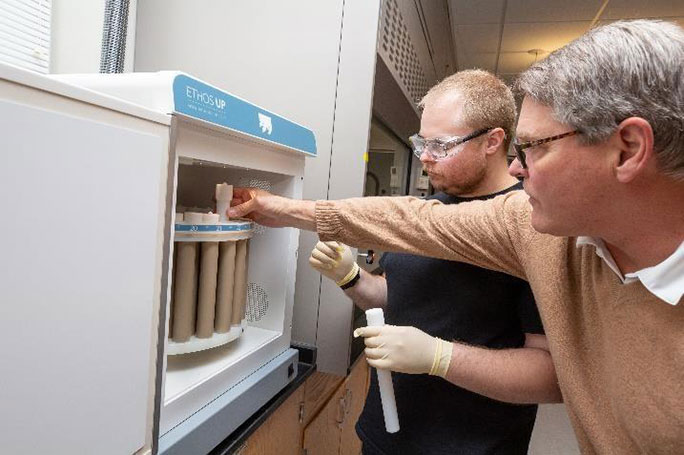
Milestone ETHOS UP Microwave Digestion System MTCSC
The ETHOS UP microwave is a powerful digestor with infrared sensors. This closed system also houses contactless temperature sensors for digestion control. Digestion is also enhanced by inbuilt two 950W magnetrons and a diffuser. The latter helps evenly distribute microwaves throughout the chamber. ETHOS UP allows for real-time monitoring of the digestion protocol using a digital camera interface and a smart screen display.
This microwave can be used for a wide range of samples and applications – biologicals [blood samples, tissues, metabolic wastes, etc.], geology [sand, clay, iron ore, soda lime, etc.], environmental analyses [dust, pollen, sludge, river sediments, etc.], food and agriculture [fruits, sugars, roots, plant tissues, etc.], petrochemistry [oils, coal, coke, etc.], cleaning and pharmaceutics [detergents, antibiotics, sugars, lipids, and waxes, etc.].
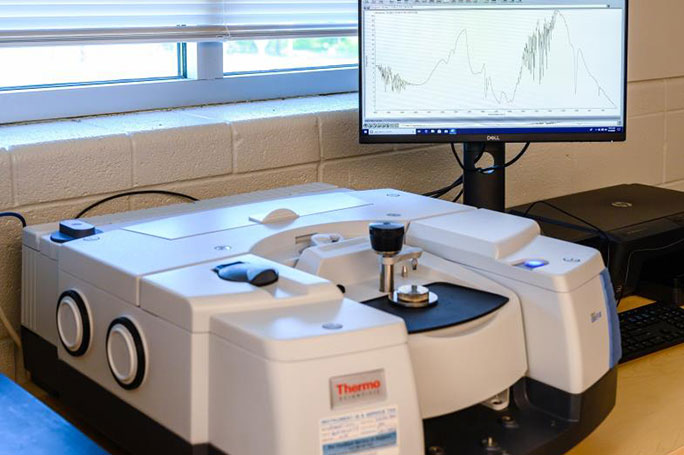
Thermo Scientific Nicolet™ iS20 FTIR Spectrometer
Fourier Transform Infrared Spectroscopy, also known as FTIR Analysis or FTIR Spectroscopy, is an analytical technique used to identify organic, polymeric, and, in some cases, inorganic materials. The FTIR analysis method uses infrared light to scan test samples and observe chemical properties.
The Nicolet FTIR provides flexibility in sampling. It has a broad range of applications and measures many aspects of a sample automatically. It eliminates several stages of manual handling of optical components. This instrument can analyze a broad range of chemical reagents with very little sample preparation. The Nicolet FTIR performs analyses from a vast range of fields including pharmaceutics, Food industry, forensics, polymer science
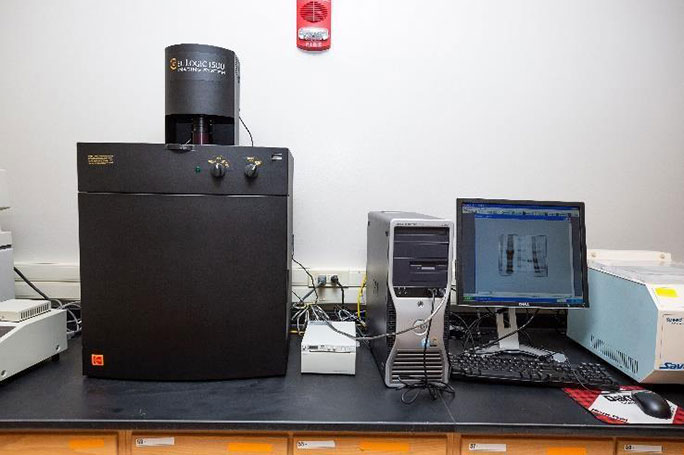
Kodak Imaging System
A gel imager is an equipment used in many biochemistry and molecular biology laboratories. It is used to images of stained agarose or polyacrylamide gels. Agarose and polyacrylamide gels are typically used to separate nucleic acids and proteins, respectively. Agarose gels can be stained with fluorescent compounds like ethidium bromide, GelRed, GelBright, etc., and polyacrylamide gels with Coomassie stain, silver, fluorescent dyes like SYPRO orange.
The KODAK Gel Logic 1500 is an advanced imaging system for chemiluminescence, fluorescence, other chromogenic gels, blots, plates, etc. This system is very sensitive, with an integrated 1.4 million pixel cooled CCD camera with mega pixel resolution, a wide sample loading chamber with ultra transluminescence lighting and data analysis software. the enhanced sensitivity is attributed to the cooled camera at -25 degrees Celsius from room temperature to increase signal to noise ratio.
It is applicable for broadband UV detection, nucleic acid gels, protein gels, colorimetric and chemiluminescence analyses. It can be used to excite a variety of dyes using its different illumination modes; Epi UV, Epi white, white-light transillumination, UV transillumination.
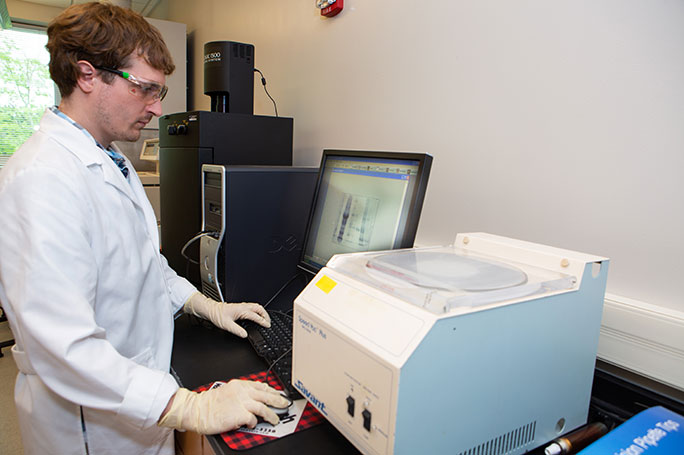
Savant Speedvac Plus SC110A Centrifuge
It is designed to rapidly evaporate liquids to concentrate or dry solutes, analytes, and residues in aqueous and organic solvents.
Built to include an automatic valve for the use of a vacuum, the SC110A-115 can handle a variety of applications including concentrating oligonucleotides, ethanol precipitates of DNA, hydrolysates of proteins, chromatography fractions, solid phase eluants and samples for analysis by HPLC, GC/MS, immunoassay, and bioassay.
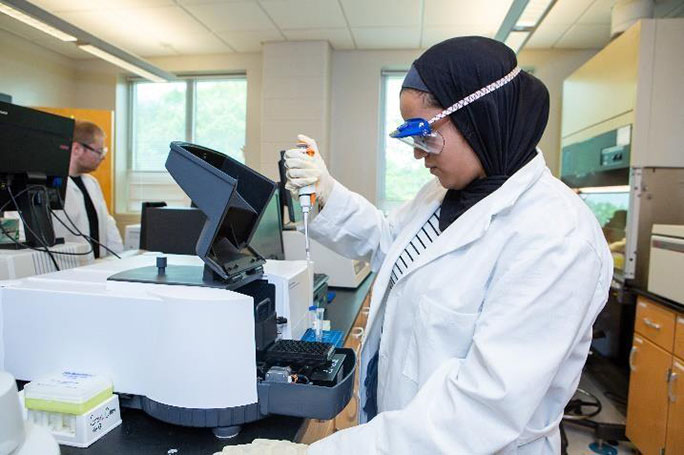
Agilent Cary Eclipse Fluorescence Spectrometer with micro well plate reader
Fluorescence spectroscopy can be coined as one of the most prominent applied domain of spectrophotometry. It is an inherent property of many aromatic/organic compounds. Fluorescence is not an isolated event. It typically occurs alongside phosphorescence, which together makeup luminescence. Luminescence is emission of light from a substance resulting from changes in excited states, but with fluorescence and phosphorescence, differ based on the nature of the excited state. When an electron is excited, and occupies an excited-state orbital, it possesses an opposite to the electron in the ground state. Thus the return to the ground state from excited state is spin allowed and occurs via emission of a photon.
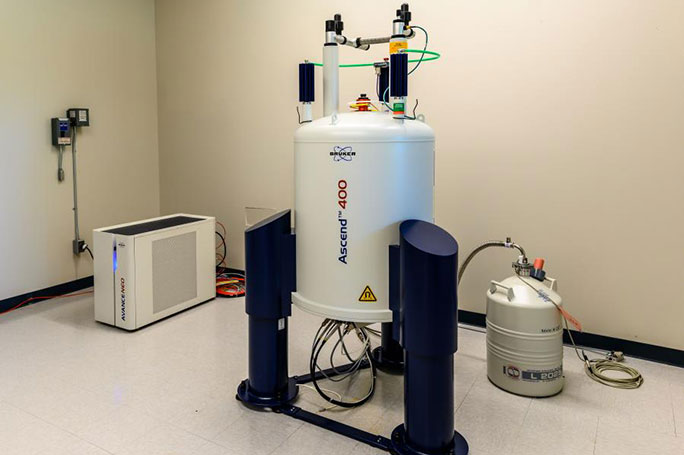
Bruker Nuclear Magnetic Resonance
It exploits the change in energy levels after exposure to a strong magnetic field, forms the basis of some powerful analytical research tools. Magnetic resonance spectroscopy (MRS) encompasses a variety of related techniques, such as nuclear magnetic resonance (NMR) and electron paramagnetic resonance (EPR) that have a diverse array of research, clinical and industry applications. The non-invasive, non-destructive nature of the technology allows the study of living cells and tissues as well as detailed analysis of solutions and body fluids. A combination of magnetic resonance analyses can provide both functional information and anatomical information, allowing relationships between the two to be determined.
The Nuclear Magnetic Resonance Spectrometer (NMR) consists of a 9.4 Tesla ultrashielded magnet with a 5 mm bore equipped with a broadband tunable probe. The instrument is a state of the art Bruker 400 MHz Avance Neo spectrometer. The instrument is essential for structural elucidation of molecules, monitoring reactions and quantification of reaction products.
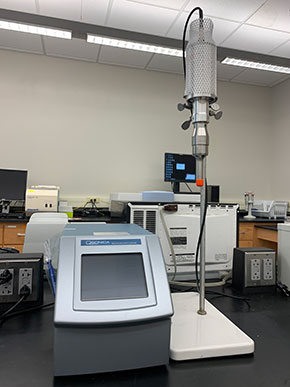
Ultrasonic Cell Sonicator 1204P16
The sonicator uses ultrasonic waves to homogenize, lyse or disrupt particles in suspension. It has a full range amplitude control for efficient sample processing and a touch screen interface to load and sync different sequences and sonication methods. Its adjustable pulse mode and temperature monitoring capabilities make it suitable to regulate and monitor temperature for temperature-sensitive samples as well as preventing overheating of the instrument.
It has a variety of applications including extracting pigments, proteins, nuclear material, and other cell organelles from plants, algae, bacteria, yeast, heart, skin tissue, etc. The intensity of the sonication process is regulated based on the cell/tissue type under investigation. Its autotune capacity serves to monitor changes in the ultrasonic frequencies and adjusts them, for a consistent output. Thus a manual autotune is not required.
Contact Us
Contact Information
- Campus Address
- Science & Technology 223
- Phone:
- (570) 422-3342
- Fax:
- (570) 422-3908 (Fax)
- Title of Department Leader
- Department Chair
- Name
- T. Michelle Jones-Wilson
- E:
- mjwilson@esu.edu
- Phone:
- (570) 422-3703



